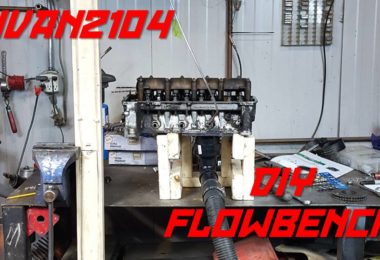 Cylinder head testing at home with cheap plumbing parts!
Cylinder head testing at home with cheap plumbing parts!
Click here to watch the video: IVAN2104 – DIY Flowbench!
Shawn has always been a huge advocate of attacking any factory cylinder head with the die grinder, in search of greater head flow and better performance. I also agree with this CFM searching mantra, especially when performance cylinder heads and manifolds do not exist or are otherwise out of reach.
With common Ford and other head designs it is a simple matter to research the work of previous head porters and mimic those successes, however with the Lada engine, this information has been somewhat less easy to find.
So how do we know if we are having a positive impact on head flow?
A cylinder head flowbench is the best place to start; it measures airflow in test conditions, somewhat like a dyno, but for air movement. It is very possible that hand porting efforts can actually harm flow, and make an engine perform worse if done incorrectly, so a flow bench is a great idea.
One problem,
They are massively expensive, and for the purpose of our IVAN2104 project, far outside the budget.
While Shawn twirled the air power die grinder impatiently, I stormed the internet in search of a home built solution. I found it, and the whole idea of building a home flow was not expensive or stupid as it sounded. This link from musclecardiy explains the theory, parts, and process to build your own DIY Flowbench.
www.musclecardiy.com/cylinder-heads/build-flow-bench-flow-testing-cylinder-heads-part-3/
We were off to the Home Building Supply store and quickly located everything we would need for the project. The following few hours were spent doing art & crafts in the shop, and at the end, much to our surprise, the contraption worked.
We did a few basic tests of the bench and found it did respond to valve lift changes and should give us our flow baseline and a means to test as we open up the ports on our Lada 1500cc cylinder head.
The test data at this time can only be compared against the items tested on this bench, we are attempting to have a calibration plate built so that we can convert our numbers to the more familiar CFM measurements. However we can measure that a port with 9 inches (of water) vacuum reading, after porting drops to 8.1 inches (for example) demonstrates a 10% flow improvement, if a change results in greater vacuum we know that we have harmed flow.
As we work with this crude but exciting tool we will publish our test data for reference and discussion.

Thanks for reading and watching, as always if there are questions or comments to share, please use the box below. Chat with us on Facebook: www.facebook.com/grandtouringconcepts
